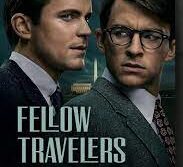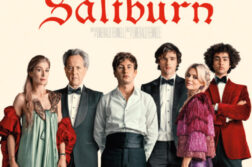THE ECONOMY wavered back and forth and the nation’s most important film festival marched into the new decade with a bang. Set against the unexpected largest snowfall in years, the Sundance Film Festival opened on January 21, breaking an opening night tradition by screening not one but three cinematic events. There was a shorts program and there was a screening of the documentary Resperto, a pro-soldier vehicle in the vein of The Hurt Locker. And then there was Howl.
Howl looks at American poet Allen Ginsberg when he was about age 29 and examines the influence that his magnum opus—which was also his first published poem—had on American society in the mid-1950’s. In some ways the poetic equivalent of Orson Welles and Citizen Kane (the director’s first work for public consumption, and of course his best), Ginsberg’s “Howl” defined a country hell-bent on making everyone happy through a kind of enforced consumerist conformity, which didn’t leave much room for gay people in the paradigm.
Divided into basically four, roughly equal parts, the movie Howl uses four different tropes to convey what Ginsberg was trying to do in the poem. The first part is essentially theatre, with Ginsberg (played by a marvelous James Franco) reading his poem at the Six Gallery on October 7, 1955, to an enthusiastic crowd, including both Jack Kerouac (Todd Rotondi) and Neal Cassady (Jon Prescott), writers and future “absent lovers” of Ginsberg. The second part uses animation (designed by Eric Dooker) to illustrate the meanings and feelings of the poem. The third part focuses on the obscenity trial over “Howl” (The People vs. Ferlinghetti), which invoked issues of free speech and the role of art in society. And the fourth part is a pseudo-documentary in which Ginsberg answers questions from an off-screen interviewer. Directed by GLBT co-directing icons Rob Epstein and Jeffrey Friedman (The Times of Harvey Milk), and highlighted by Edward Lachman’s magnificent direction of photography, Howl intermingles these four sets to brilliant effect.

While the poem “Howl” said so many things about America and Howl the film says so much about America then and now, the greatness in this film lies in the fact that the filmmakers managed to capture both Ginsberg and “Howl” at its vital essence: the voice of desire and fulfillment, of communication and acknowledgment, by and for those who have been ignored or ostracized by society.
Another selection at SFF 2010 warranting the highest admiration was Secrets of the Tribe, directed by Brazilian filmmaker José Padilha (Bus 174), which digs deep into the walls of latter-day anthropological study by taking a look at how a few—perhaps too many—Occidental anthropologists examined the Yanomamo Indians of the 1960’s and 1970’s.
Viewed as a pristine hunter-gatherer society, the Yanomami Indians lived in seclusion for millennia before becoming the ethnographic study du jour. Once invisible, they became the most filmed and studied tribe on the planet. Moreover, the Yanomami were often subjected to humiliating acts of pedophilia and exploitation. One of the most notable cases is lodged against French anthropologist Jacques Lizot, a disciple of the world-renowned anthropologist Claude Levi-Strauss, who is accused of molesting and raping Yanomami boys. To his credit, Padilha subjects a vast array of experts to questioning about the ethical implications of this study. Napoleon Chagnon, whose 1968 book Yanomamo: The Fierce People is the best selling ethnography of all time, gave machetes to the natives in exchange for their cooperation, while Kenneth Good married an underage girl (by Western standards) in order to further his career (for which he was viciously criticized by his archenemy, Chagnon).
While there’s plenty to be appalled about, Secrets of the Tribe is also quite funny, insightful, and entertaining. The egos, the hypocrisies, and the battles of wits—and the questions about motive, opportunity, and objectivity in academic pursuits—keep the narrative moving forward at a good clip.
Another selection worth mentioning was Contracorriente (Undertow), a story about a seemingly upstanding member of the community, Miguel, who lives as he’s expected to in his small Peruvian seaside village. Madly in love with his pregnant wife Marieta, who’s about to give him a son, Miguel has plenty to be thankful for. So why would he go and fall in love with a male artist named Santiago? That kind of “perversion” could only get him into trouble.
Written and directed by Javier Fuentes-León, Contracorriente walks a narrow line between taking a stance against homophobia and holding homosexuality accountable for disrupting tradition. The way most Peruvians in the film treat Santiago is deplorable. Mired in superstition, they alternately ignore and harass the artist, sometimes throwing things at his house. Despite all this, the selfish Santiago expects Miguel to throw away everything for love, despite the fact that Miguel doesn’t consider himself gay. To compound matters, Marieta is a sympathetic character whose life is being ruined by her husband’s affair.
This strain of sympathies continues until the very end, with Santiago getting the better of Miguel at Marieta’s expense. The film makes it clear whose demands were more justifiable. Marked by strong performances yet plagued by troubled conceits, rather than promote understanding, it is easy to see how this film could be used by anti-gay organizations to further their agenda.
John Esther, a freelance writer based in Los Angeles, is a frequent contributor to this magazine.






